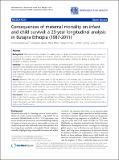| dc.contributor.author | Moucheraud, Corrina | en_US |
| dc.contributor.author | Worku, Alemayehu | en_US |
| dc.contributor.author | Molla, Mitike | en_US |
| dc.contributor.author | Finlay, Jocelyn E | en_US |
| dc.contributor.author | Leaning, Jennifer | en_US |
| dc.contributor.author | Yamin, Alicia Ely | en_US |
| dc.date.accessioned | 2015-06-02T12:20:33Z | |
| dc.date.issued | 2015 | en_US |
| dc.identifier.citation | Moucheraud, Corrina, Alemayehu Worku, Mitike Molla, Jocelyn E Finlay, Jennifer Leaning, and Alicia Ely Yamin. 2015. “Consequences of maternal mortality on infant and child survival: a 25-year longitudinal analysis in Butajira Ethiopia (1987-2011).” Reproductive Health 12 (Suppl 1): S4. doi:10.1186/1742-4755-12-S1-S4. http://dx.doi.org/10.1186/1742-4755-12-S1-S4. | en |
| dc.identifier.issn | 1742-4755 | en |
| dc.identifier.uri | http://nrs.harvard.edu/urn-3:HUL.InstRepos:16120917 | |
| dc.description.abstract | Background: Maternal mortality remains the leading cause of death and disability for reproductive-age women in resource-poor countries. The impact of a mother’s death on child outcomes is likely severe but has not been well quantified. This analysis examines survival outcomes for children whose mothers die during or shortly after childbirth in Butajira, Ethiopia. Methods: This study uses data from the Butajira Health and Demographic Surveillance System (HDSS) site. Child outcomes were assessed using statistical tests to compare survival trajectories and age-specific mortality rates for children who did and did not experience a maternal death. The analyses leveraged the advantages of a large, long-term longitudinal dataset with a high frequency of data collection; but used a strict date-based method to code maternal deaths (as occurring within 42 or 365 days of childbirth), which may be subject to misclassification or recall bias. Results: Between 1987 and 2011, there were 18189 live births to 5119 mothers; and 73 mothers of 78 children died within the first year of their child’s life, with 45% of these (n=30) classified as maternal deaths due to women dying within 42 days of childbirth. Among the maternal deaths, 81% of these infants also died. Children who experienced a maternal death within 42 days of their birth faced 46 times greater risk of dying within one month when compared to babies whose mothers survived (95% confidence interval 25.84-81.92; or adjusted ratio, 57.24 with confidence interval 25.31-129.49). Conclusions: When a woman in this study population experienced a maternal death, her infant was much more likely to die than to survive—and the survival trajectory of these children is far worse than those of mothers who do not die postpartum. This highlights the importance of investigating how clinical care and socio-economic support programs can better address the needs of orphans, both throughout the intra- and post-partum periods as well as over the life course. | en |
| dc.language.iso | en_US | en |
| dc.publisher | BioMed Central | en |
| dc.relation.isversionof | doi:10.1186/1742-4755-12-S1-S4 | en |
| dc.relation.hasversion | http://www.ncbi.nlm.nih.gov/pmc/articles/PMC4423767/pdf/ | en |
| dash.license | LAA | en_US |
| dc.subject | Maternal mortality | en |
| dc.subject | infant mortality | en |
| dc.subject | child survival | en |
| dc.subject | Ethiopia | en |
| dc.title | Consequences of maternal mortality on infant and child survival: a 25-year longitudinal analysis in Butajira Ethiopia (1987-2011) | en |
| dc.type | Journal Article | en_US |
| dc.description.version | Version of Record | en |
| dc.relation.journal | Reproductive Health | en |
| dash.depositing.author | Finlay, Jocelyn E | en_US |
| dc.date.available | 2015-06-02T12:20:33Z | |
| dc.identifier.doi | 10.1186/1742-4755-12-S1-S4 | * |
| dash.contributor.affiliated | Yamin, Alicia | |
| dash.contributor.affiliated | Finlay, Jocelyn | |


